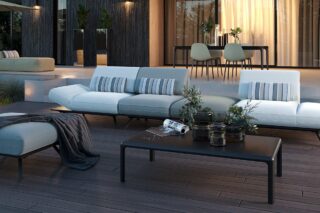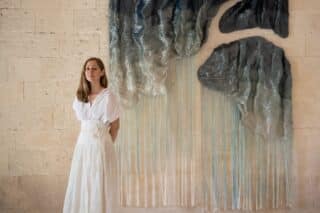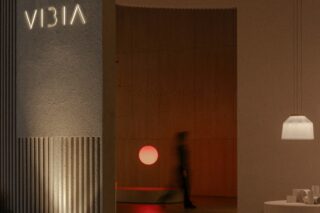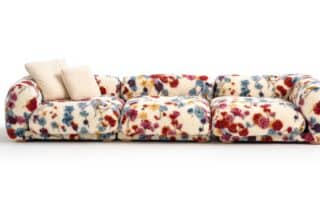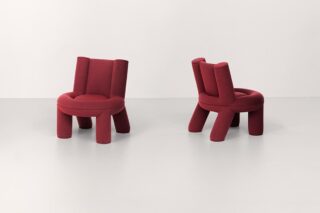LED lighting has transformed workplaces and homes of people throughout the world. The bulbs last longer and are more energy efficient than incandescent lighting. But, until recently, LED light quality has lagged—bulbs typically produce a surfeit of blue light that studies show interfere with sleep. Further, due to limited light spectrums they emit, these bulbs also distort reality making it difficult to distinguish between different shades of color.
This past January, a company called Soraa, co-founded in 2008 by 2014 Nobel Prize winner Dr. Shuji Nakamura, released several consumer light bulbs that deal with the shortcomings. One is the Radiant LED, a violet based bulb that contains a fuller spectrum of light than the traditional blue based LED. The other is Soraa Healthy, a violet based LED that contains no blue light whatsoever.
ArchiExpo e-Magazine spoke recently with Chief Product Officer for Soraa TJ Grewal about the company’s new products.
ArchiExpo e-Magazine: What are the advantages of violet-based LED for consumers?
Grewal: Soraa was founded on the idea of creating a violet LED and the reason was to create a full spectrum of color. Blue based LEDs have a difficult time rendering deep reds and they have another gap around cyan.

“Light that loves you.” Courtesy of Soraa.
We are already popular in the hospitality sector and in museums and galleries, where people are the most color-critical. They want to make sure that the art they are showing looks correct. The other application of violet based LEDs is to produce a white light that has none of this blue spectrum that can lead to poor sleep quality, which impacts your awareness, your wellness and your health.
ArchiExpo e-Magazine: So why aren’t violet LED’s more common?
Grewal: The lighting industry is typically based off of blue LEDs. Violet LEDs are generally very expensive. What Soraa invented was a way to make violet LEDs very small so they could be put into things like lamps to produce that full spectrum and that is where LEDs have become an alternative to halogens. You saw a lot of people not wanting to give up halogens because the blue LED option was awful. Now with an LED option based off of a violet bulb, even halogen lovers can say, “now you are finally producing a full spectrum color spectrum.”
ArchiExpo e-Magazine: Where would you put Soraa Healthy in your home as opposed to Soraa Radiant?
Grewal: There are some people who will say I want to reduce my blue diet throughout the day and they will want to put Soraa Healthy everywhere. But blue light is not necessarily a bad thing for you physiologically, you just need it in the morning because it is a trigger to stop melatonin production so that you become active and alert. Personally, I put Soraa Healthy in places where I am willing to make the tradeoff against the full spectrum color–so not in my living room where I have a lot of art and I want that to look great. In my kids’ bedrooms, I have Soraa Healthy. Your body needs a period of no blue light to go into sleep mode and Soraa Healthy makes it possible to do that in a way that makes it look as though you are not living in a light experiment.
ArchiExpo e-Magazine: Don’t gadgets have nighttime light modes that switch off blue light to aid with getting us ready for sleep?
Grewal: Every form of LED light that is out there today, whether it is a lightbulb a television screen, a laptop or your iPhone: all of that is based on LEDs that start with a blue LED. But that blue LED is always there as a backlight what night shift does is reduce the amount of blue that is emanating from your screen. What they are doing is applying other color filters to reduce the amount of blue that is hitting your eye and the only way they achieve that is by applying other color filters on top of that blue light. But they cannot get it down to zero.
ArchiExpo e-Magazine: Do you use technology in your bedroom?
Grewal: You cannot avoid screens. Should people use iPhones and tablets before they go to sleep? They shouldn’t. With your screens, you don’t have the alternative you either turn it off or use it. But we are giving consumers the choice with lamps. In our home with our kids, I use Soraa Healthy because I want to prepare their bodies for sleep.
ArchiExpo e-Magazine: What about sleep time light bulbs that aid with your circadian rhythms?
Grewal: There are sleep time light bulbs and I have walked into rooms wearing a bright fluorescent orange sweatshirt and you cannot tell what color it is because you are literally inside of a bug light. It is like that dramatic of a color shift and, as consumers, we don’t want to live in that world. We want normal looking light and that is what we invented with Soraa Healthy—it looks like a normal lightbulb and we are not compromising anything on color.

“Sleep Habits of the Rich and Famous” by Soraa
ArchiExpo e-Magazine: Does the Radiant LED have the potential to transform the way people approach decorating their homes?
Grewal: You have consumers who are spending all of this time on interior decorating and they go to showrooms and select swatches and they are selecting what color fabric to use on their sofas and what color their rug is going to be—is it this shade of red or that shade of red? But nobody ever thinks of changing their lightbulb and they can have terrible quality lighting. That is why some of the top fashion brands use our light. When merchandisers show five different shades of a red dress, they want consumers to see that there are five different shades of a red dress. But when you take those dresses home and put them under bad lighting, they will all look the same. All whites look the same too under bad lighting. You won’t notice the nuance of the white Carrera marble countertop that you just put in, and the white napkin that you put on top—all of these objects have different shades, and under bad LED lighting, you will not see the different shades.
ArchiExpo e-Magazine: Do you think that the general public is aware of the shortcomings with blue-based LEDs versus incandescent bulbs and your new violet based LEDs.
Grewal: Most people don’t realize that the lighting got really bad with the modern LED—lighting became a utilitarian thing and nobody would pay attention to it. I am lucky enough to live in a place where I had a lot of natural light in sunny southern California. If I lived in where I grew up in Toronto, light would matter to me more there. But consumers don’t realize that they have an alternative. You know that when you went to that museum or that high-end store that things looked better. So why shouldn’t you have that experience at home? We are trying to teach people that lighting matters for color and for health.
ArchiExpo e-Magazine: Do you think that it is possible that someday we will someday be living in a violet-LED based world?
Grewal: With traditional LED’s the effort was always to make things more efficient and was done at the expense of color. And everything is continually getting flatter and flatter, so the challenge is to make LEDs smaller and smaller. However, at some point the violet LEDs will be small enough to put into those applications.








